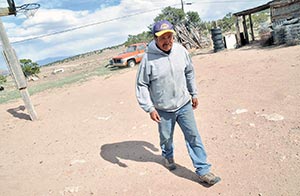Tsoodzil looms large in Prewitt hearts, landscape
By Cindy Yurth
Tséyi' Bureau
PREWITT, N.M., June 11, 2009

(Special to the Times - Donovan Quintero)
Jones Garcia, 51, a resident of Kin Ligaii, in the Prewitt, N.M., area west of Tsoodzil, says the sacred mountain is a healer.
If you ask Jones García what it feels like to live in the shadow of Tsoodzil, words fail him.
The weathered 51-year-old Diné crosses his arms over his chest and hugs himself, closing his eyes and smiling.
García does not blame the mountain for the uranium dust he believes killed his brother and father after they worked for years in Kerr-McGee's mine near the summit. He blames Kerr-McGee.
The mountain, he says, is a healer.
"If I have a headache, I just go up there and it goes away," he said.
García's extended family is one of just a handful eking out a living in this impoverished eastern outpost of the Navajo Nation known locally as Kin Ligaii, White House, after a now-crumbled Anasazi ruin that used to stand guard there.
Most of them are related either by marriage or clan - "We're all either Salt, Mexican or Two Who Came to Water," said Dejay Yazzie, 22.
And in spite of the ramshackle buildings, rocky soil and paucity of jobs, most of them wouldn't live anywhere else.
"This is where our heart lies," explained Yazzie. "Most of our houses are built facing east, Navajo way. So the first thing you see when you open the door is the mountain."
When you say "the mountain" in Prewitt, everyone knows which mountain you mean. Mount Taylor, lone and regal, dominates the eastern horizon - the sacred southern sentinel of Navajo country.
Of the locals the Navajo Times interviewed for this article, only Yazzie had heard about the New Mexico Cultural Properties Review Board's recent decision to declare the mountain a "significant traditional cultural property," protecting it somewhat from development (see accompanying story).
"It's good," Yazzie said. "They're finally listening to us. If the white people want to put a resort or something up there, they should have to ask us. We were here before there were white people in New Mexico, before Columbus even came to America."
Mary Hudson, 74, said she's a Christian, not a traditionalist, but she still believes the mountain deserves protection.
"It's a good mountain," she said in Navajo, with photographer Donovan Quintero translating. "It's beautiful. They should leave it alone."
While Hudson doesn't believe, like the traditionalists, that digging up uranium invites spiritual ills, she's seen enough local miners die of lung disease that she doesn't like it.
"Uranium makes our lungs weak," she said. "They should stop mining it."
Tsoodzil attracts medicine men from miles around whom the traditional locals believe bless their community just by passing through, perhaps praying and sprinkling corn pollen as they approach the southern gateway to traditional Diné bikéyah.
"They come to collect the plants they need, like (mountain) tobacco," explained García, or just to make a pilgrimage.
Traditional practitioners from the surrounding pueblos, which also venerate the peak, sometimes show up as well.
As for the locals, they have another reason for ascending the rugged flanks of the extinct volcano.
"The best piñons grow up there," confided García.

